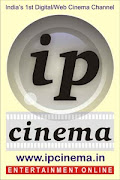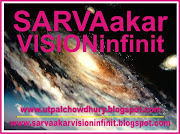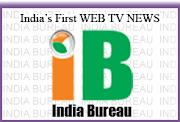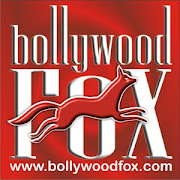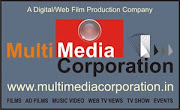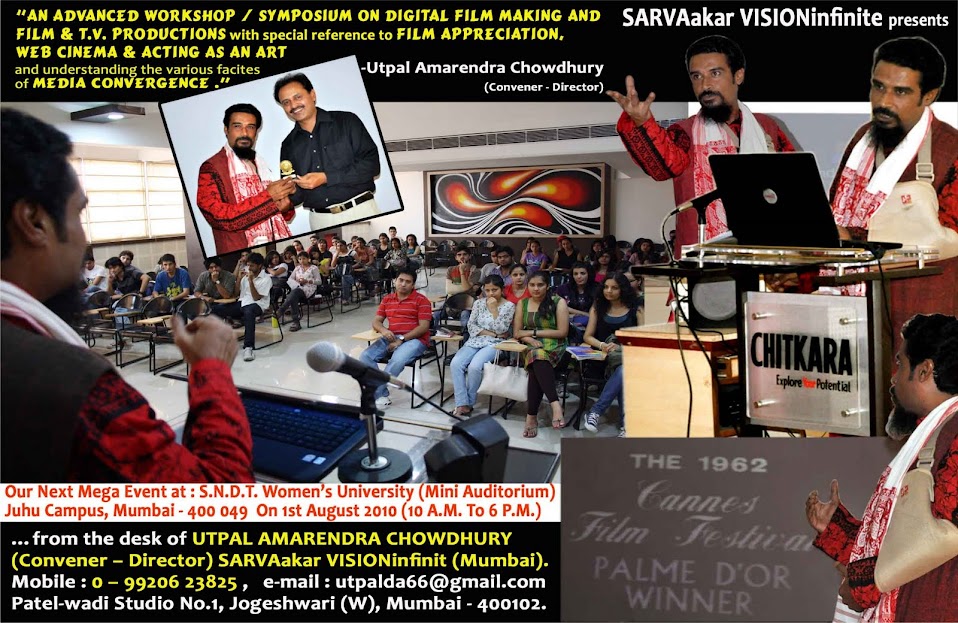SYLLABUS FOR ONE YEAR PG DIPLOMA ON FILM, TV & DIGITAL PRODUCTIONS PREPAIED FOR MEDIA INSTITUTIONS BY:
Utpal Amarendra Chowdhury (Convener-Director)
http://www.utpalchowdhury.blogspot.com/,
utpalda66@gmail.comSarvaakar Visioninfinit, Ph.: 09920623825,
FEATURES AT A GLANCE FOR ISB & M SCHOOL OF COMMUNICATION’S -“AN ADVANCED DIPLOMA ON: TELEVISOIN PRODUCTION & DIGITAL FILM MAKING”.
What : An Advanced Diploma On - Television Production & Digital film making.
when : The Academic year of 2010-2011 (1st August, 2010 to 31st July, 2011)
For whom : Film & TV enthusiastic people who want to join the industry as a professional. students of Various Departments of Mass Communication - Production & Media Studies. All men & women in pursuit of Creative Art, Film & TV viewers who have got an urge to know the basics of Film-TV & Digital Video Production as an art and want to develop their mental framework for "Understanding Cinema" and join the industry as a professional.
Age : No bar.
Minimum Qualification : + 2 and Above.
medium of instruction : English (Spoken Hindi can be added.)
Facilities : Industry Professionals are regular Guest Faculties other than Core Faculties. The Course is Practical, Intensive & Demonstration Oriented and are based on Audio - Visual materials. All the sessions are Interactive & Participatory. A Well equipped Studio & Library exist for students. Study Tours and Student Exchange Programmes and on-Job Trainings etc. are arranged.
Study materials : To be supplied by the Institute.
Duration : One Academic Year (2010 - 2011).
This Course is divided in 4 Trimesters. 1st & 2nd Trimesters are common for all the participating Students, where as the 3rd Trimester is for specialization on any 3 under-mentioned subjects. In the last, i.e. the 4th Trimester the participating students will be sent form on-job Training in the film & TV Production House / Industry.
1. DISCIPLINES / SPECIALIZATION OFFERED :
(a) Direction & Screenplay.
(b) Camera & Lighting.
(c) Editing & Sound Recording
2. No. OF STUDENTS TO BE ADMITTED :
30 students per yea, Subject to maximum of 10 Students per discipline / Spelization.
3. ASSESSMENT PARAMETERS
(a) Attendance (minimum 80%)
(b) Class Room Practical’s.
(c) Written tests / Class tests/ Viva Voce and other assignments.
(d) Student’s Exercises & Projects.
(e) Study Tours & ON JOB TRAINING ASSESMENTS.
4. VACATION SCHEDULE :
(a) Government Holidays.
(b) Summer & Winter Vacations (Short Period with Project works).
(c) Prominent Festivals.
(d) Project & Exam. Preparation Periods.
5. The Course is divided in 4 Trimesters (3 months period each)
1st Trimester
Basic Theory & Practical on Television Production & Digital Film Making.
2nd Trimester
Advanced Theory & Practical on Television Production & Digital Film making
Practical Digital Film Making :...my First Project (a documentary film in Digital format.)
Study Tours
3rd Trimester
Specialization period. Each participating student has to specialize in any one area.
1) Screenplay & Direction
2) Camera & Light or
3) Editing & Sound
N.B. : My First Diploma film in Digital format.
4th Trimester
On Job Training in any Film & TV Production House / Industry.
FEE : Rs. 1,20,000/-
Rupees One Lacks and Twenty Thousand only
(Course fee - Rs. 1,00,000/- + Regd. Fee - Rs. 20,000/-)
Location : ISB&M School of Communication
(PUNE, KOLKATA, NOIDA & BANGLORE)
Hostel : Paying Guest Accommodation are available for Boys & Girls separately near the Institute Campus.
*** CONTENTS OF THE COURSE :
(a) Lectures (Theory).
(b) Practical’s / Lab visits.
(c) Workshops / Industry Visits.
(d) Exercise / Projects.
(e) Film Screening Sessions.
(f) Interaction with Professionals.
AN Introduction to
isb&m advanced diploma on : Televesion Production & digital film making
In this programme, students are thoroughly immersed in the full spectrum experience of developing and producing Tv Programme & Digital Film Making. The Programme introduces students to picture creation, fusing theory instruction with project assignments and complete productions. Students learn the language of picture production, explore fundamental techniques and learn some of inputs in acting, videography, directing, editing, producing, screenplay writing and sound. Students learn theoretical concepts in class from a faculty comprised of working professionals but more specifically through production experiences with core faculty as seasoned mentors.
Additionally, in ISB&M School of Communication multiple screening facilities, students regularly watch cinema from around the world, analyse and discuss the same and learn fundamental concepts in Film Appreciation, Music Appreciation, International Art, Literature & Culture, and Production Design. Students apply these skills through developing and producing their own films. They develop the crucial filmmaking team skills necessary for industry success.
In the programme, students make 2 film projects on Digital Video format (in Group / Team-work) :
1. My First Project (2nd Trimester)
2. My Diploma film (3rd Trimester)
COURSE CONTENTS IN BRIEF
Modules :
A group of well designed modules have been included in the programme, each with a definite course objective, enabling the students from the outset, to learn every crucial aspect of Film Production & Digital Filmmaking.
Direction
Objective of the Module :
This module provides students with a working knowledge of the director's responsibilities on a TV & Digital Film production. Completion of this course enhances opportunities for students to qualify for entry-level professional industry positions and as a director in the Film, TV & Digital Video industries.
Description :
The Direction module, from the script to the screen stage, focuses on artistic and technical knowledge, while giving students the opportunity to develop their creative talent through production experience. During lectures, students learn the basic techniques of direction, including acting, directing actors, composition, script analysis, pre-production, casting and theory. Emphasis is placed on the co-operation and interaction of various disciplines and the director's ability to communicate his/her ideas, to balance the oftentimes differing demands of writer, producer and actor, and to work collaboratively. The module explores visual storytelling strategies, the grammar of Film, TV & Digital Video, aesthetics, characterization, shot breakdown and storyboarding techniques.
Screenplay Writing
Objective of the Module :
This module aims at developing communication strategies through various creative English/Hindi composition genres and forms. Completion of this course enhances a student's possibility for advancement of writing skills, script reading and evaluation skills.
Description :
This module trains students to understand story structuring, character development, interplay and entwining of characters and their lives. Through a series of writing projects, students learn to incorporate common literary devices and narrative structures into their creative endeavors.
Digital Videography
Objective of the Module :
This module provides students with a working knowledge of the operation of a HD / HDV / SDV / Mini DV camera. Completion of this course enhances opportunities for students to qualify for entry-level, professional industry positions as a cameraman in Film, TV & Digital Video industries.
Description :
This module introduces students to the Art and Operation of digital video cameras. Students learn the use of terminology, camera structure and camera operation. Subjects covered include composition, lenses, basic lighting, operation, filters and exposure for all outdoor conditions.
Editing
Objective of the Module :
Completion of this module equips the students with the elementary technical and aesthetic aspects of editing. Completion of this course enhances opportunities for students to quality for entry-level professional industry positions and as an editor in Film, TV and Digital Video industries.
Description :
In this module, students understand the technical challenges and conceptual attributes of the editing process working through non-linear and of course linear systems. They learn to operate the Final Cut Pro, as they simultaneously develop their skills in conceptual understanding and artistic strategies necessary to transform raw footage into emotionally powerful and meaningful stories.
Sound recording & design
Objective of the Module :
Completion of this module provides students with a fundamental understanding of supporting visuals with appropriate sound elements.
Description :
This module makes a critical analysis of the sound component of films. Students are given topical Inputs on the Arts, Science & Technology aspects for recording sound and designing it for Film, TV & Digital Video Production. Basic skills of location recording, track laying and mixing are learnt, covering the different stages of principal photography and post-production.
Music Appreciation
Objective of the Module :
This module develops the student's music and film sensibilities and further enhances aesthetical values of their perception of story-telling along with valuable tools and skills for creating film soundtracks.
Description :
The Music Appreciation module is designed to develop the ability of the students to recognize the sound and appearance of individual instruments, families of instruments, and their varied roles in ensemble settings from a vast canvas of the music and cinema of the world. Special emphasis will be placed on exploring the emotional quality of the Film, TV & Digital Video experience brought about by the music it carries.
Film appreciation
Objective of the Module :
This module educates students in the historical aspect of Indian cinema and the growth process that evolved. Completion of this module enables students to gain insight into the diverse cultural contributions of key historical groups and periods and learn how they have influenced module tastes, trends and attitudes.
Description :
The Film Appreciation module examines the art of appreciating the contribution of the different facets in creating a Film, TV & Digital Video Production . The microanalysis of different role plays, craft and techniques applied to the process of making a film provide a greater understanding of the medium and its intricacies. Students would be provoked to understand their own personal responses, questioning their notion of personal 'taste' and going beyond it in order to derive pleasure and learn from the vast resources of world cinema.
The course focuses on the development in technologies that led to the emergence of moving images, its commercialization and the revolution that followed. The early phase of silent cinema, followed by integration of sound, development of colour and growth of new technologies up to digital cinema are covered. The influences of early Europe on films and evolution of Indian cinema including Hindi and regional cinema along with its pioneers are covered through the course.
International Art literature & culture
Objective of the Module :
Students gain insight into the diverse cultural contributions of key historical groups and periods and learn how they have influenced module tastes, trends and attitudes. The familiarization to artistes with great works shall develop the students' artistic expression. Completion of this module enables students to make more informed comparative and critical assessments of art, culture and social issues.
Description :
The module is a presentation and study of Liberal Art, Fine Art and Literature from across the globe. Students are introduced to the language of arts in various media while examining the purpose of art. It investigates the work of key artistes in the field of painting and literature in various historical periods emphasizing how and what art communicates about the culture from which it is produced.
Producing
Objective of the Module :
This module gives students a fundamental understanding of the professional world of Filmmaking, Television Production & Digital Video Production. Completion of this course enhances opportunities for students to qualify for entry-level, professional industry positions as production executives and other positions related to the production and post production functions.
Description :
The module examines the entire Film, TV & Digital Video production process from scripting to post-production in the digital film medium. Students become familiar with each of the positions involved in a professional Film, TV & Digital Video production. They are given the ability to successfully analyze problems and to develop solutions related to scheduling and budgeting resources. This module given them elementary skills of Scheduling & Budgeting their projects on professional software that is industry friendly.
Production Design & Art Design
Objective of the Module :
Completion of this module educates students in the proper methods of creating a coherent visual concept for a film or television production.
Description :
The module focuses on the production designer and his/her crew within the art department. It introduces the principles of production design and how they apply to a Film, TV & Digital Video. The overall ambience and visual appearance of a Film, TV & Digital Video is explored through the fundamentals of design. The student will become familiar with the production design process used to create interiors and exteriors. Students will also get an overview of the different elements of design such as make up, hair dressing, wardrobe and costume that contribute to the visual appearance of a film.
3. INTEGRATED (1st & 2nd TRIMESTER)
Theory & Practical- Common to all disciplines. My first project in group during 2nd Trimester (10mints. duration)
4. SPECIALIZATION (3rd TRIMESTER)
(a) Theory, Practical & Workshop - Specific to individual disciplines.
(b) Common Exercises/ Projects - Common for all disciplines according to their specialization - Diplomea Film of 10 mints. in group (HDV format).
PREAMBLE
THE POLICY
The domain of cinema revolves around the objective of how to communicate with picture and sound in a manner that is creative. Film for the last hundred years has in fact been effectively doing so. The aim of ISB & M School of Communication is to accord its students with appropriate skills and techniques to master the hardware and software of the film and video industry, so that they may reach professional standards in their respective fields to gain employment in the above industry.
ADMISSION AND SPECIALISATION
Students will be admitted for the One-year Advanced Diploma course after going through an interview. This screening process should be able to test the applicants’ aptitude and earnestness to explore and express through the audio-visual medium. The students will be required to mention their area of specialization before joining the course. However, students’ performance in the common integrated course will be instrumental in further pursuing their respective areas of specialization. Change of specialization will not be considered in any circumstances.
ATTENDANCE & ASSESSMENT
As per Academic By- Laws.
TEACHING
As a premier institute of our country, the tenets of the teaching philosophy in ISB & M School of Communication would be based upon addressing the need to groom the students as independent, thinking individuals who are able to give form to their inner conflicts by creative means. To achieve this, basic classroom teaching and discussion are of prime importance. These classes will be followed up with intensive practical exercises, collaborative projects with other departments and workshops with outside professionals. Further, every attempt will be made to keep the students abreast with the latest trends and developments in the media and technology.
In addition to the normal classroom lectures, practical, there will be Student Projects/ Exercises, which will be of a similar pattern for every term. Such projects will comprise of assessment oriented practical activities, essentially production based to facilitate the students to gain practical exposure in the fields of products, location research, set construction etc. that are connected to the making of a film. The thrust of the projects will be to develop the quality of independent approach and learn from their own initiative and performance. Modest budgets will be allocated, if necessary for specific projects against sundry expense, set construction etc. The students will be taught the importance of affecting economy in production.
TIME TABLE
The Course is perceived as a full-time residential course. Weekly academic routines will be displayed by the end of the previous week; it will be obligatory for the students to attend all the theory and practical classes. Attending the General Screenings and the Film Study screenings is mandatory for students during the Integrated Course. From time to time professional filmmakers and technicians will be invited to present their works to the students and faculty. Informal discussions will follow these sessions.
SCHEME OF ASSESSMENTS / FINAL EXAM. JULY,2011 (LAST WEEK)
1. Direction & Screenplay (Theory) 50 + 50 Marks
2. Camera & Lighting (Theory) 50 + 50 Marks
3. Editing & Sound Designing (Theory) 50 + 50 Marks
4. Film Analysis & History (Theory) 50 + 50 Marks
5. Practical (50 marks to each modules) 200 marks
6. My First Film & My Diploma Film 50+100 Marks
7. On Job Training Report 100 marks
8. Yearly Internal Activities 100 marks
9. Viva & final Interview before panning out 50 marks.
Total = 1000 marks.
(a) Pan mark - 40 - D grade
(b) Below 50 Marks - 3rd division - C grade
(c) Below 60 marks - 2nd division - B grade
(d) Below 70 marks - 1st division - A grade
(e) 70 marks - distinction - A+ grade.
============================================
SYLLABUS
1ST & 2ND TRIMESTER (3MONTHS AUG’10 TO OCT’10 & NOV’10 TO JAN’10)
COURSE CONTENT FOR TV & DIGITAL FILM PRODUCTION
DIRECTION & SCREENPLAY WRITING
THEORY CONTENTS :
1. Direction Theory :
Role of the contemporary Director, Screen Grammar, Spatial Connections, Temporal Connections, Shot Construction, Basic Mise-en-scene, Acting Fundamentals, Importance of Sound, Major Film Theories.
2. Screenplay Writing :
Basic Screenplay Writing, Screenplay Formats, Narrative Structure, Three Act Structure, Hero’s Journey, Myth and Archetypes
3. Film History & Analysis:
(a) Excerpts from Indian, European, Russian, American, and other silent film classics will be shown in class followed by Interactive discussions, which will be focused on “modes of production” of silent films.
(b) The advent of “Sound” in cinema and the birth of the “Talkies” : Interactive discussion on the impact of sound in Film Industry and changes it produced.
(c) A brief look on the following major movements in cinema, Russian Social Realism, German Expressionism, French Realism, Post war Italian Neo-Realism, French New wave and Regional Indian Cinema, Film Analysis : Textual analysis of one documentary and one fiction feature will be done in the film analysis classes.
(d) Production Basics : Pre-Production, Production, Post-Production
(e) Music Appreciation
(f) Art History And Visual Perception :
PRACTICAL CONTENTS :
1st Module : Constructing Images with visual and sound components. Writing observation notes within campus.
2nd Module : Actuality trip, Writing field notes
3rd Module : Field trip with digital video camera.
4th Module : Three-shot exercise in ‘real time’ Demonstration
5th Module : Demonstration in DV time compression/expansion
6th Module : Shooting the DV film
7th Module : Developing the continuity screenplay.
COURSE CONTENT :
VIDEOGRAPHY
THEORY CONTENTS
BASIC POTOGRAPHY :
1. Natural light and its properties. Shadows and its properties
2. Eye its response to light Perception of light
3. Pinhole camera - its principle.
4. Optics - preliminary Introduction.
5. Prism - its basic properties.
6. Simple lens - Advanced optics (Aberrations - their types & their remedies)
7. Mirrors
8. Compound lens - their properties.
9. Aperture, Shutter - their mechanisms & application.
10. Image making tool - camera.
11. Types of cameras.
12. Photometry.
13. Meters Incident light meters, reflected light meters, spot meters, centre weighted meters, matrix metering.
14. Advanced Image controlling techniques - Application of filters.
15. Basic concepts of exposure.
16. Basic Principle of video image formation & Television technology, Image & exposure control systems, different formats.
VIDEOGRAPHY THEORY
1. Introduction to Digital Camera principle, different parts and their function.
2. Introduction to Light Meters (Incident & Reflected - principle, usages.
3. Introduction to Focusing Screen, Formats View Finders.
4. Introduction to Colour theory and practice.
5. Checking of a Digital Camera and accessories before a shoot, and preparation for a shooting unit.
6. Advance theory and practice of video Image formation & Television technology, Image, exposure control systems.
PRACTICAL CONTENTS
1st MODULE
1. Visual training, i.e. to how to see with a dummy frame of 4:3 ratio. Students to submit observation reports as sectionals.
2. Demonstration and discussion through basic photo techniques : focus/shake/ over-under normal exposure/ subject movement/camera panning / portrait focus/zone of focus/in camera meter/camera level/ head space etc.
Demonstration of simple SLR camera - basic functions/controls & Digital Still & Video Camera.
3. Students to shoot simple composition with classical approach; to keep record of technical detail and basic compositional aspect with reference to the respective frame no.
4. Each student to select 10 frames from their own construct positive prepared by the department. Mount the frames, prepare the Digital Video Programme for projection & discussion.
5. Demonstration of Developing.
2nd MODULE
1. Shoot with Digital Video camera in reference of Depth of field, Image size, Perspective, tensing - technical shooting.
2. Completed DV to be presented for discussion.
3. Use of filters, lensing.
4. Prepare project and then analysis as per previous module.
5. Demonstration of electronic Camera and usage.
6. Practice Shoot with electronic Cameras.
COURSE CONTENT :
EDITING
THEORY :
The Evolution and History of Editing
Lumiere Brothers - Georges Melies - Edwin S. Porter - D. W. Griffith - Constructive Ediing Kuleshov and Pudovkin-Organic Composition and Montage - Dialectical Symbiosis - Different Forms of Montage Elsenstein to Dovzenkho.
CONTINULTY IN EDITING : Various Devices & Transitional Dimensions of Editing. Elements of Continulty 180-Degree Rule, Spatial, Temporal, Rhythmic and Narrative Continuity. Exceptions to 180-Degree System. Dimension & function of film sound, Parallel Action, Timing, Pace, Rhythm.
Introduction to Edit Room Practices : Use of Editing Equipment, Editing procedure - from Rushes to Fine Cut Technique of Film Cutting Room, Production Techniques, Editor’s responsibility, Introduction to various gauges and processed films.
TELEVISION / VIDEO / DIGITAL MEDIA
Development of TV Technology, Video Signal, Transmission of Video Data, Vedio Recording Principles, Video Quality and Resolution, Tape Formats other medium, Basic Introduction to the Two Systems of Editing - Linear and Non-linear/Analogue & Digital. Computer Fundamentals, Use of Computer in Programme Making for Film & TV.
Transmission System (PAL/NTSC/SECAM). Off line/ On line Editing.
Basic steps of film post-production in DNLE system.
PRACTICAL :
DIGITAL FILM
Introduction to Cutting Room and the Equipment Used, Film materials, Handling of Editing Room Equipment.
(Silent Continuity Rushes - 16mm/video-are to be given to each student as continuity exercise).
Editing of 16 mm Continuity with Sound-Synchronization and Sound Overlap (One Exercise).
TELEVISION / VIDEO / DIGITAL MEDIA
Editing of Silent Continuity in Video cut to cut only, Editing of simple dialogue Sequences on DNLE.
Editing of silent DV exercise.
COURSE CONTENT :
SOUND DESIGNING
THEORY :
SOUND RECORDING BASICS
Script to Screen, Basic Principle of Sound, Acoustic, Psychoacoustics, Basic Magnetic Recording Method, Recording Chain, Digital Recording Method, Concept of P.C. Based Recording, Microphones & Loudspeakers, Film, TV & Digital Video Track Analysis, Pilot Synchronization, Different Film, TV & Digital Video Formats.
PRACTICAL :
Introduction of Nagra, Microphones, Audio Studios, DSM etc.
Recording on Nagra E/Nagra 4.2, Transfer on Stripe, Introduction of Lapel & Gun Mic on Boom Rod, Demo. of Multitrack Recording. Dubbing & Mixing.
Recdording and Mixing on Digital Audio Workstation, Track laying on Digital Audio Workstation.
Departmental Audio Project.
Demo of multitrack recording, Dubbing & Mixing.
COURSE OUT-LINE IN SHORT TO BE ADDED IN TELEVISION PRODUCTION
(a) An introduction to Television History & Early experiments.
(b) Television Programmes Genres - soap opera, Talk Show, News, Sports, Reality Show, Discovery, Geography, Animals etc. and the Story of Indian Television.
(c) Television Lighting & Floor Management.
(d) Broadcast Reporting & Shooting - News idea & planning.
(e) Writing to video, Influence of Cinema on TV & Video Cinema in TV.
(f) Various Video formats – Low band, High Band, U-Matic, Beta, Digital etc.
(g) TV Visual Story telling for Television & Video for Social & Political Education.
(h) Interviewing, News Stories, Packaged News & News Documentary and Ethics of Television.
(i) Preparation for successful Anchors and Co-coordinators for Television.
(j) Cable Television - Satellite Television : Impact.
(k) Television Programme & New Transmission.
*** Multi-Camera Television Production & on-line Editing.
TELEVISION PRODUCTION : IDEA TO SCREEN
Selection of the programme topic :
Developing programme briefs (Objectives, Contents, Duration etc), Researching the topic, Programme Resources, Style and format, structuring the programme, Storyboard and Script Designing, Script Layout.
Video Recording and Editing :
What is editing? Rules of editing, Editing sound; U-Matic, Beta & VHS, Types of editing, Cut to cut, A/B roll, Assembly and insert editing.
Media Research Methodology :
Writing support materials, Designing Evaluation Tools and Techniques, Evolution and field testing of programme, Preview and Analysis of programme.
BASICS OF CAMERA, LIGHTS AND SOUND
Camera :
(a) Video Camera, Types of Video Camera
(b) Different types of shots, camera movements, Tilt, Track, Crane movement etc.
(c) Lenses : Different types of lenses and their application
Lighting :
(a) Lights and Lighting
(b) Basic of lighting, Techniques.
(c) Different types of lights used in videography
(d) Use of filters & reflectors.
Sound :
(a) What is sound? Unit of sound, voicing
(b) Types of microphones, use of audio mixers for recording & editing of sound.
TELEVISION PRODUCTION LAB
Focuses on a production of TV proramme from conceptualization through post-production editing familiarizes with:
Ø Story treatment
Ø Scripts,
Ø Storyboards,
Ø Budgets,
Ø Floor plan, sets, make-up costume, jewelry, lights, audio, graphic rehearsals,
Ø Shooting schedules
Ø Post-Production editing
PHOTOGRAPHIC EQUIPMENT
Cameras - types - formats - lens - their types and functions - film - types and functions - accessories.
Camera and Photo :
Shots - focus - shutter - speed - selection of subject - different types of photographs - action - photo editing - procedure - pictures for newspapers and magazines - developing photographers’ manual and computerised photography.
Photographing people:
Portrait and still, wildlife; environment; sports; landscape; industrial disasters; photography for advertising; conflicts-war-political and social photography.
COURSE OUT-LINE IN SHORT TO BE ADDED DURING 2ND TRIMESTAR FOR DIGITAL FILM MAKING.
vPART 1
SOME IMPORTANT POINTS ON FILM, TELEVISION, DIGITAL MEDIUM AND FILM & TV ACTING FOR FILM ASPIRANTS:
Chapter - 1
(a) Indian & International Film History & Film Theory
Chapter -2
(a) Cinematic Time & Space (b) Audio & Visual Rhythm (c) Camera Eye- Lenses & Aperture (d) Camera Distances -Movements viewpoints (e) Crossing the line (f) Continuity (g) Understanding Basics of Script Writing (h) Film-Video-Digital Format (i) PRE-PRODUCTION Plans.
Chapter - 3
(a) The PRODUCTION Stage (b) Understanding Lighting & colour (c) The Shooting Process (d) Composing a frame (e) Taking a shot (f) Before the Camera Job - ACTING (Audition).
Chapter - 4
(a) How films are made (b) How to analyze a Film (c) Film & TV Programme reviewing (d) Digital Cinema Here & now (e) Understanding the Era of Web Cinema (f) Future of Media in Convergence Era (g) The Era of Independent Film Makers.
Chapter - 5
Practical classes with video camera in details. (b) Practical classes with still camera in details.
vPART 2
Chapter-1
SOME IMPORTANT POINTS ON ACTING FOR FILM ASPIRANTS:
(a) Observation (b) Imagination (c) Sense Memory (d) Emotional memory (e) Diction, Voice & Speech (f) No Hamming (g) Listening (Action & Reaction) (h) Photogenic Appearance of Physical Fitness (i) The Five Most Important Factors for the Improvisation - 1. What are you doing? (Purpose) 2. Why are you doing? (Reason) 3. With whom you are doing? (Relationship) 4. When are you doing (timing) 5. Where are you doing a scene? (Place) (j) Pause - Modulation - Expression & MANY MORE IMPORTANT POINTS ON FILM & TV ACTING.
3rd TRIMESTER (SPECIALIZATION) Feb, 2011 to April, 2011.
Course Content:
Direction & Screenplay Writing.
Break up, course content, teaching method & assessment for 10-week theory and practical
1. Direction :
The construction of cinematic time and space, temporal and spacial articulation in shots, ways one shot relates to another shot.
Understanding the content/sub-text of a scene, Reasons for Breaking down a scene into shots.
Mis-en-scene, Construction of meaning by using set, props, colour, costume, look of the actors, nature of sounds, composition, movement, acting and choreography.
The evolution of the long take Director’s style.
Non-Fiction films: Brief history, types of documentary, technique, ethics, various available funding and pitching. Advertising and Promotional films.
Method of Teaching : Class room lectures illustrated by screening of film & video clips.
Method of assessment : 2 written projects.
2 Screenplay Writing :
Film Narrative, The principles of story design, Substance of story, premise and controlling idea, the Inciting Incident, act design, scene analysis, effective dialogue writing, composition, crisis, climax, resolution.
Adapting a story for film screenplay.
Teaching Method : Classroom lectures
Method of assessment : 2 written projects
1. Scene Break down of a selected feature film
2. An hour-long screenplay adapted from a story.
3. Film Theory :
Aim and contents
v To study primary texts from classical and modern film theories.
v In what cultural and social contexts are the texts written?
v To which philosophical traditions and discussions have the texts contributed?
Method of teaching :
Study materials will be provided to the students, so that the students are familiar with the texts before coming to the class, and the classes will be interactive in nature based on the leading questions given below.
v What are the vision and key concepts, which the texts are based on and how are they related to one another?
v To what extent do these visions and key concepts still make since if we relate them to, contemporary discussion about film and to contemporary film practice?
Method of assessment:
Written Project.
Sound Design :
Course content
To see is to understand, we say “I See” when we understand, a picture is surely worth a thousand words, sound however actively shapes out interpretation of the visual, sound directs our attention (a biological survival Imperative)
What is “natural Sound”?
Virtually always manufactured rather than captured at the moment of filming.
Selective as the Lens : The difference between the ear & a microphone.
Has a source of emanation but surrounds the listener.
Creates the continuity necessary in a disjointed medium of rapidly changing images - sutures
We do not automatically identify a sound with its source.
Hearing requires a greater event duration than vision for recognition.
Naturalism means producing the desired effects (Walter Murch).
Design theory & concepts.
Sound track analysis.
Terminology for analysis
Building the track
v What do we want the audience to hear ..... feel
v What size space
v Natural, staged or artificial location/state of mind
v Mood
v Color and shape of elements in the frame
v Context : what are we trying to preserve, imply or invent
v What individual elements are required to build the larger gestalt/sound event?
Method of Teaching : Class Room lectures illustrated by film clips.
Method of assessment : Written Project :
1. Sound track and back ground scoring analysis of a given film, TV & Video production.
5. Art Direction :
The representation of space affects the reading of a film, Depth, Proximity, size and proportions of the places and objects in a film can be manipulated through camera placement and lenses, lighting, decor, effectively determining mood or relationships between elements in the dietetic world.
Method of teaching:
4 Two hour long sessions illustrated by film clips.
Followed by week long practical classes (5 days, 3 hours in the second half of the day) where each student has to draw a ground plan set to scale with elevation of an imaginary set with images of the props.
Method of Assessment :
1. Written Project : The ground plan and album of props images.
6. Music :
Composing for films.
The key function of music in films:
Creating a more convincing atmosphere of space and time, Underlining psychological refinements -- the unspoken thoughts of a character, or the unseen implications of a situation, Serving as a kind of neutral background filler, Building a sense of continuity, and Underpinning the theatrical build-up of a scene, and rounding it off with a sense of finality.
Composing Process
Understanding the environment film composers must work within. The role played by these figures the producer, director, editor, executive producer, orchestrator/arranger and in some cases the music editor and the music supervisor.
The basic process
Meeting filmmakers, reading script, screening the film
Spotting the Film, TV & Video Productions.
Planning budgets and recording schedules
Conceptualizing
Working out timings / Synchronization
Composing
Orchestrating
Recording
Dubbing
Method of teaching :
Classroom lectures illustrated with film clips and studio demonstration of music recording and mixing
Method of assessment : Part of Sound Design written project.
7 Productions :
The Indian production system
Economics of the Indian film Industry, Sources of financing, Co productions/collaboration: Indo European film encounters, Distribution and exhibition, legal aspects and trade regulations, Censorship In Indian cinema, Shooting in India, National film policy : Import and export, Indian television Practical Training : Learning to use “Movie Magic” budgeting software
Modes of Teaching : Classroom lectures.
Production Assignment : After the completion of the studio project and documentary each Direction student will have to submit a detailed list of expenses incurred under the various budgetary heads. Total production cost up to the first married print.
Course Content :
Videography
Theory
1. Appreciation of other visual art forms.
2. Photometry Compound Lens - Details Aberration-corrections, Colour correction/ coating, Mirrors, Image
3. Sensitometer in details.
4. Emulsion manufacturing, granularity and spectral response.
5. Different lighting approaches- application & usage.
6. Advanced colour control practice- Filters, light control and colour temperature.
7. Colour emulsion control practice filters light control & colour temperature.
8. Colour Processing and Printing, Usage of Analysers, Liquid-gate printing and other types of printing system.
9. Application of electronic technology in cinema (Basics), Tele-cine Transfer
10. Projection theory and practice.
11. Appreciation of other visual art forms.
12. Understanding Screenplay from cinematographer’s point of view.
PRACTICALS
Basic Studio Lighting for Videography
1. Introduction to different types of light-unit, electrical connections and light control unit.
Demonstration of Various types of Film Video & Digital Camera.
Basic studio Lighting input. A student will learn to handle different situation in lighting in indoor and with artificial light.
A student will learn to handle different situation in lighting in both outdoor and indoor and with natural light and artificial light and with colour film stock.
Visiting a colour film procession laboratory.
Students continue Intensive practice outdoor/Indoor lighting.
Electronic videography DV-HDV-SDV-MiniDV.
(a) Understanding basic Digital Video concepts. Emphasis on formats & Resolutions
(b) Understanding single camera applications, ENG, Interview setups,
(c) Understanding the application of DV Image measuring tools like Waveform Monitor & Vectroscope.
(d) Documentary workshop which involves exploring & understanding different kinds of documentary approach which includes practical and shooting within the workshop.
Colour Videography :
(a) Working with different colour backgrounds, understanding the concept fo colour contrast.
(b) Working the luminaries having different colour temperature. Light Filtrations, Camea Filtrations for Image manipulation.
(c) Understanding to interpret different emulsions. A student will learn to handle different situation in lighting essentially studio based with artificial light and with colour film stock.
(d) Visiting colour film processing laboratory to understand colour processing and grading.
Mise-en-scene Workshop
(a) This will explore along with the cinematographer expert the visualization of narrative with emphasis on Aspect ratios, shot designing, Lighting, Artist/ Character & Camera Movements.
(b) Emphasis on Set Designing and cinematographer’s participation in the process
(c) Execution of the conceived script/ narrative
(d) Also explore location lighting practices, indoor-outdoor matching, Exterior night lighting with the cinematographer.
Make up & Costume workshop
Combined with Direction department
Extensive Ad./Promo workshop
Followed by practice
Extensive Practicals (Film, TV & DV)
(a) Studio based lighting practical with different lighting Fixtures, creating different lighting situations. Day & Night, staging shots with varied camera movements.
(b) Location lighting practical with emphasis on indoor-outdoor Machine & Exterior Night lighting with camera movements.
(c) Practice on DV oriented towards Documentary shoot.
Course Content :
Editing
Theory
Film
Classical Hollywood Narrative in Sound Era, Editing norms.
Preview and analysis of selected films.
Editing Dialogue Sequences, Sound design and Structure - how sound Influences edit decisions.
Creative treatment of sound in Editorial construction.
Preferences to National & International Eminent Film maker’s Creation.
Shot to shot analysis of selected sequence of chosen directors.
Style and treatment In Documentary Reportage, Personal/Imaginative Documentary. The Documentary and the use of Sound. Sound Montage. Cinema Verity and Different genre of Documentary
SELECTED DOCUMENTARY DIRECTORS - CONTEMPORARY WORLD CINEMA
Shot to shot analysis of selected sequence of chosen directors.
Editing Musical Sequences/ Playback, Music Video/ RR Marking on work prints. Preparation for Negative
Cutting- Editor’s Final Responsibilities.
VIDEO & DIGITAL MEDIA
Video Signal, Theme Code & CIL
Understanding analogue video, Video Signal, Time Code, CIL.
Evolution of digital theory, Various Aspects of DNLE System, different standard / digital formats - DV, DVCAM/DVC PRO, DIGI BETA, HDTV, Digitization, Output from DNLE System, SDV, Mini DV etc.
Sampling, Picture quality, (Digital and Analogue), Resolution Compression, Storage devices. Component/composite video. Aspect Ratios and conversion. Audio equalization, Audio design Post production, Understanding of Surround Sound Audio Monitoring System. Track Laying, Mixing, Editing Film on Video. Tele-cine process. Basics of animation and motion graphics. On line & off line editing - FCP & Avid.
Practical
Film
Dialogue Sequences. Creative application of sound.
Editing Musical Sequence. Editing documentary (video), Developing news stories.
Video & Digital Media.
Online Editing Video a material with DVE (Special effects generator)
Understanding the Installation of a Video Editing Suite
DNLE- understanding/practice of editing software.
Audio-Postproduction, Track-Laying, Playback Exercise.
Practices-Basics of animation and motion graphics.
Course Content:
Sound Recording
Theory
(a) Content
Basic Principle of Sound:
Simple Harmonic Motion, Beat, Resonance, Fourier Series
Audio Electronics :
Understanding the specifications of the ‘Audio equipment’ (e.g. impedance, dynamic range, harmonic distortion etc.)
Relation between metering & listening audio :
dBu, dBm, dBv, dB SPL.
Music Theory & Music listening :
Structure of Indian Song, Chromatic Scale, Save Notation, Octave, Harmonics, Third Harmonic Distortion.
Magnetic Recording Theory :
Magnetization Curve, Hysteresis Loop, Biasing, Heads, Transport, Record/Replay Equalization.
Loud Speaker and it’s placement :
Components of Loud Speaker, Cross Over Network, Active & Passive Speaker.
Microphone :
Directivity & Frequency response, Type of Microphone, use of Microphone, Principle of Cordless Microphone.
Acoustic :
Sound Reflection, Diffraction, Absorption, RT, Stationary Wave, Hass Effect.
Psychoacoustics :
Human Hearing Response.
Processors :
DSP (Reverb, Delay, Chorus, Flange Etc.) Dynamics (Noise Gate, Compressor - Limiter, Expander).
Film Track Analysis :
Multi-channel format
Digital Recording Theory :
Basics of Binary Number System, Gates, Sampling Frequency, Quantization, Aliasing, PCM, Mp3, Dithering, Clock For Digital Audio Synchronization.
Optical Recording Theory :
Basics of variable Area & Variable Density Recording
C.D. Technology :
Elementary C.D. & DVD recording technology.
Synchronization :
Time Code, Chase & Bi-phase Synchronization, RS 422 Synchronization, Concept of 24 & 25 Frames Synchronization.
Practical :
Sync. Recording, Out Door Recording
Music Recording & Mixing
Dubbing
Song Editing
Familiarization of Electronics Component, Half & Full Wave Rectification, Amplifier, Oscillator
Track Laying
Foley Recording
B.G. Recording
Use of Processor
Mono Re-Recording for Film, 500 Feet per Student Optical Sound Transfer
Surround Track laying & Mixing on Surround Digital Audio Workstation
Song Recording & song mixing.

